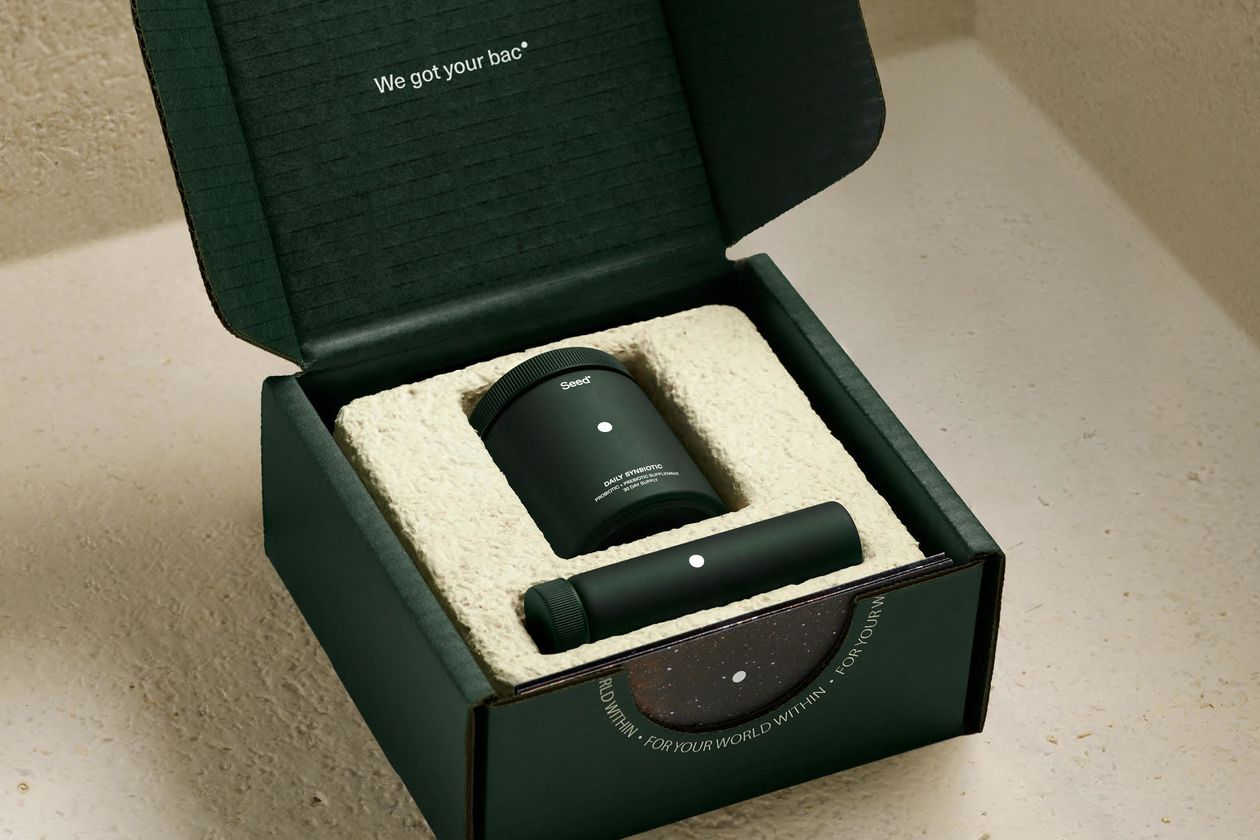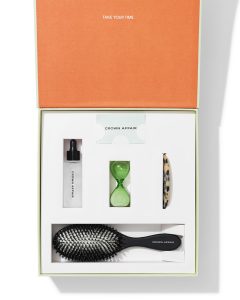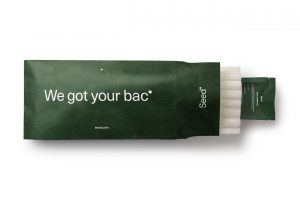Startups Wrap Brand Identity With Sustainable Packaging

Companies are focusing on whether a customer feels guilty or virtuous about how the product was boxed to drive business results
[Image Caption] Seed Health’s new customer package includes a glass jar and a travel vial nestled inside a compostable tray made from mushroom fibers. PHOTO: SEED HEALTH
The first time Seed Health Inc.’s probiotics arrive at a new subscriber’s door, they come in a handsome glass jar with a powdery finish and minimal branding. The capsules nestle in a compostable mushroom-fiber tray and a recycled paper box that is the same moss green as the jar.
This is the only time customers will see this presentation. The following month, capsules arrive in a compostable pouch with corn foam padding that dissolves in water.
Seed Health aims to deliver a specific experience for customers: The feeling of gaining membership to a club, while making a virtuous purchase.
“We try to think about the ritual of filling up the jar with new capsules—the feeling that you’ve started this ongoing relationship,” said Ara Katz, who co-founded Seed Health in 2018 and developed the sustainable packaging system in-house.
Orders have increased 600% since early 2019, Ms. Katz said, declining to be more specific.
The age of e-commerce and two-day delivery from Amazon.com Inc. has brought a storm of hastily packed cardboard boxes and plastic mailers with it.
Consumers received 8.6 billion e-commerce packages in the U.S. last year, up from 7.6 billion in 2018, according to ShipMatrix Inc., a software provider that analyzes shipping data.
More companies are trying to drive business results by extending their focus beyond the actual products for sale to concentrate on moments that get increasingly bundled under terms like “consumer experience.”
These moments range widely, from how a product feels in a customer’s hands to whether they feel guilty or sanctimonious about discarding the packaging later. Startups in particular are motivated to find ways to stand out among larger, more established rivals.
For some companies, packaging creates a cachet around the product—especially when it becomes the subject of admiring “unboxing” videos on Instagram or YouTube.
“When you get a beautiful package, you feel like you’re part of the brand’s universe,” said Dianna Cohen, founder of Levitate, a brand strategy and marketing consulting company, and of Crown Affair Inc., a direct-to-consumer hair-care line.
“You buy something because it’s part of your identity,” Ms. Cohen said. “To not address that on the packaging is a miss.”

Contents of a Crown Aair box — PHOTO: CROWN AFFAIR
The January launch of Crown Affair played out in real time via a host of unboxing videos on Instagram posted by early recipients of the brand’s pale avocado-green boxes, each of which display Crown Affair’s signature brush, comb and hair oil with museum-like care.
Other posts played up compostable and reusable elements of the packaging. New packaging considerations, however, can mean more cost to companies.
To deliver a sustainable packaging experience to people who order Veles, a new home-cleaning product made from acetic and lactic acids and water found in food waste, founder Amanda Weeks sources materials that account for $5 of a $16 price tag on a 16-ounce bottle.
This compares with a 16-ounce bottle of everyday cleaner from Mrs. Meyer’s Clean Day that costs under $4 on Amazon.
“I’ve had to defend our pricing,” Ms. Weeks said.
It is a multipronged defense: Instead of cheaper plastic, Ms. Weeks chose aluminum bottles (“aluminum is infinitely recyclable, and it’s also lighter than glass”) and while the nozzle is plastic (“not a lot of options there”), it is clear and doesn’t contain a metal spring, giving it a higher value on the recyclables market.
The bottle itself is reusable and comes in a terra cotta matte paint, chosen because it will likely look attractive on any countertop.
Customers will only ever need that one bottle; Veles plans to offer a $10 refill program for its cleaning solution.
Amazon says it works constantly to reduce waste, including by collaborating with manufacturers to monitor throughout the supply chain.
Its sustainable packaging initiatives have reduced packaging weight by 27% per shipment over the past four years, according to a spokesman.
“For packaging Amazon deliveries, we’re moving from mixed material packaging solutions— paper with plastic cushion mailers—to material that is fully compatible in either paper or plastic recycling streams,” the spokesman said, adding that the company expects the move to be complete by next year.
Sixty percent of Amazon packaging is compostable, he said.
Sourcing materials is another challenge for companies that want to provide a certain packaging experience. “How we got here is not glamorous,” Ms. Katz said of Seed Health’s low-impact packaging system. “The best materials for our future aren’t ready for scale.”

Seed Health capsules also come in a compostable pouch with corn foam padding that dissolves in water.
PHOTO: SEED HEALTH
It took over a year of sleuthing for small vendors—“the people on page 10 of a Google search”— to find materials that met the needs for sustainability and still looked enticing, Ms. Katz said.
“It takes a lot of creativity to make a mushroom tray look beautiful,” she said. “It can easily look like a block of cheese.”
But the research is getting easier, she said.
Seed Health shares its vendor information on its site. Further options can be found on the website A Better Source, an online eco-packaging repository that launched in the fall.
Created by Jennifer Wright, a graphic designer in Austin, Texas, the volunteer-powered site surfaces packaging ideas for small businesses, and tracks new solutions hitting the market.
“A lot of businesses we talk to are realizing that consumers are willing to pay more for sustainable packaging,” Ms. Wright said.
“There are so many beautiful, fascinating materials coming onto the market made from things we wouldn’t expect,” she said. That tactile novelty is really enticing to consumers.”
Corrections & Amplifications
A 16-ounce bottle of Veles cleaning spray costs $16. An earlier version of this article incorrectly stated it costs $20. (Feb. 24, 2020)
Original Post: The Wall Street Journal, Margaret Rhodes, 2/24/20